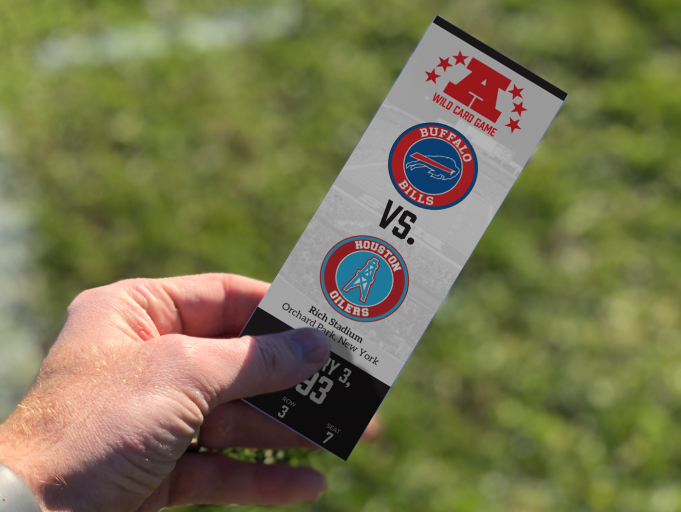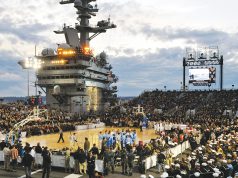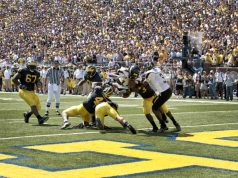Had the now ubiquitous “Win Probability Chart” been a thing in 1993, the Buffalo Bills and their fans would not have been happy with what it showed at halftime of their AFC Wild Card playoff game on Jan. 3 of that year. As the Bills shuffled off to their locker room, they trailed the visiting Houston Oilers, 28-3, and the real-time tracking line of the chart would have been about as close to “Houston = 100 percent” as it could be without the game actually being over.
“At halftime, we joked a bit about whether the planes were running on time at the airport because we thought about going home early,” said 19-year NFL official Dale Orem, who served as the line judge on what would become a historic day in NFL history, with a chuckle. “It was a great day in Buffalo and the weather was actually pretty decent.”
It was a relatively pleasant Saturday afternoon, at least by the standards of western New York in January. The field was free of snow, the winds were mild when they blew at all and the temperature at kickoff was 38 degrees. For the officiating crew, the gloves some members wore were a convenience rather than a necessity.
Umpire Bob Boylston, a 21-year NFL official, had a better-than-front-row seat for Houston’s first-half dominance, positioned as he was, just a few yards off the line of scrimmage on the defensive side of the ball. Pick your statistic of choice: the Oilers scored a touchdown on each of their four first-half possessions, they nearly tripled Buffalo’s time of possession, they outgained the Bills, 290 yards to 75, and Houston quarterback Warren Moon was 19-for-22 with four touchdown passes.
“As officials, we were always aware that we had to be ready for a comeback any time we go out there,” noted Boylston. “You just never know what is going to happen.”
“In games like that you always discuss the fact that we have to officiate like it is 0-0,” added Orem. “You’ve got to keep to your routine and procedures as closely as you can even in a game like that.”
While theoretically possible, a Buffalo comeback seemed highly unlikely. Buffalo’s star linebacker Cornelius Bennett and Hall of Fame quarterback Jim Kelly were both injury casualties and hadn’t even dressed for the game. Backup quarterback Frank Reich, now head coach of the Indianapolis Colts, was making his first start of the entire season, and on Buffalo’s first possession of the third quarter, one of his passes was deflected into the arms of Houston’s Bubba McDowell, who galloped into the end zone to give the Oilers a 35-3 lead. Following the interception, Reich and the Bills scored on each of their next four possessions.
“The game just made a complete turnaround after that,” explained Orem. “Houston was so efficient in the first half, but in the second half, the efficiency switched teams. The enthusiasm of the players and coaches changed on a dime.” In less than seven minutes of game time, Buffalo had closed to within 35-31, and finally took a 38-35 lead with Reich’s fourth second-half touchdown pass and his third to Andre Reed.
“It was two completely different games,” said head linesman Terry Gierke. “As Buffalo began to come back, the crowd really got into it and it was both unforgettable and unbelievable.”
It was the best of times for Gierke, who was stationed along the Houston side of the field for the first half and the Buffalo side for the second half. Thus, for the entire afternoon he was among players and coaches who were piling up points faster than a pinball machine. It was the worst of times for line judge Orem; thanks to the fact that the line judge and head linesman switch sidelines at halftime, he spent his first half with an increasingly morose group of Buffalo players and coaches and his second half among an increasingly astonished and desperate group of Houston Oilers.
Numerous crew members mentioned that Buffalo’s second touchdown in the third quarter, which made the score 35-17, triggered an astonishing shift in momentum. That word was no longer simply a broadcaster’s crutch, it was a near-physical presence in the stadium reinforced by a mammoth wave of crowd noise that Gierke described as “literally deafening.” Even though the Bills still trailed by 18, with 22 minutes of game time remaining, their comeback was taking on an air of inevitability.
That particular touchdown was the source of some intrigue, according to referee Gerald Austin. He believes the drive that produced it may have started by accident. In the 1990s, the league office sent its officials game tapes (recorded on VHS cassettes!) and the crew members usually received them the following Wednesday. While studying the game tape, Austin saw Buffalo kicker Steve Christie’s plant foot appear to slip, turning what was supposed to be a conventional deep kickoff into an impromptu onside kick that Christie himself recovered. Buffalo head coach Marv Levy indirectly validated Austin’s observation when he maintained in a 2013 interview that the play was, in fact, a flub.
While Buffalo’s second touchdown was important, it was one key play among many. “There was no one big play or ‘a-ha’ moment in the game,” recalled Orem. “But it became more and more obvious to (the officials) that we have to stay in control because it was going to be one heck of a game.” Umpire Boylston noted that as the game tightened up in the third quarter, the chatter between players along the line of scrimmage diminished.
“In playoff games there’s less chirping than there is in the regular season anyway, and during this game the chirping fell away as it got closer,” he noted. The crew’s control and management of the game was such that despite the unprecedented reversal of fortunes in the second half and the resulting swings of emotion, there were no post-whistle personal fouls or unsportsmanlike conduct penalties called the entire game.
Houston caught the Bills with 12 seconds left in regulation when the Oilers kicked a tying field goal. Christie subsequently won the game for Buffalo with a 32-yard field goal in overtime, completing the largest comeback in NFL football to that date.
Orem noted the entire crew was “very proud to be part of a game like that. It is quite a conversation piece to be able to say we were there on the field for the greatest comeback in history.”
Austin, a practical man, mentioned one other prominent memory of that amazing afternoon — the Buffalo fans simply didn’t want to leave the stadium at the end of the game. Their extended celebration meant empty streets for the van that took the officials to the Buffalo airport, a trip that was usually a tangled and tedious process. Austin was pleased to note that even with the overtime, each of his crew members made his scheduled flight home.
Van Oler is a freelance writer from Milford, Ohio. *
Had the now ubiquitous “Win Probability Chart” been a thing in 1993, the Buffalo Bills and their fans would not have been happy with what it showed at halftime of their AFC Wild Card playoff game on Jan. 3 of that year. As the Bills shuffled off to their locker room, they trailed the visiting Houston Oilers, 28-3, and the real-time tracking line of the chart would have been about as close to “Houston = 100 percent” as it could be without the game actually being over.
“At halftime, we joked a bit about whether the planes were running on time at the airport because we thought about going home early,” said 19-year NFL official Dale Orem, who served as the line judge on what would become a historic day in NFL history, with a chuckle. “It was a great day in Buffalo and the weather was actually pretty decent.”
It was a relatively pleasant Saturday afternoon, at least by the standards of western New York in January. The field was free of snow, the winds were mild when they blew at all and the temperature at kickoff was 38 degrees. For the officiating crew, the gloves some members wore were a convenience rather than a necessity.
Umpire Bob Boylston, a 21-year NFL official, had a better-than-front-row seat for Houston’s first-half dominance, positioned as he was, just a few yards off the line of scrimmage on the defensive side of the ball. Pick your statistic of choice: the Oilers scored a touchdown on each of their four first-half possessions, they nearly tripled Buffalo’s time of possession, they outgained the Bills, 290 yards to 75, and Houston quarterback Warren Moon was 19-for-22 with four touchdown passes.
“As officials, we were always aware that we had to be ready for a comeback any time we go out there,” noted Boylston. “You just never know what is going to happen.”
“In games like that you always discuss the fact that we have to officiate like it is 0-0,” added Orem. “You’ve got to keep to your routine and procedures as closely as you can even in a game like that.”
While theoretically possible, a Buffalo comeback seemed highly unlikely. Buffalo’s star linebacker Cornelius Bennett and Hall of Fame quarterback Jim Kelly were both injury casualties and hadn’t even dressed for the game. Backup quarterback Frank Reich, now head coach of the Indianapolis Colts, was making his first start of the entire season, and on Buffalo’s first possession of the third quarter, one of his passes was deflected into the arms of Houston’s Bubba McDowell, who galloped into the end zone to give the Oilers a 35-3 lead. Following the interception, Reich and the Bills scored on each of their next four possessions.
“The game just made a complete turnaround after that,” explained Orem. “Houston was so efficient in the first half, but in the second half, the efficiency switched teams. The enthusiasm of the players and coaches changed on a dime.” In less than seven minutes of game time, Buffalo had closed to within 35-31, and finally took a 38-35 lead with Reich’s fourth second-half touchdown pass and his third to Andre Reed.
“It was two completely different games,” said head linesman Terry Gierke. “As Buffalo began to come back, the crowd really got into it and it was both unforgettable and unbelievable.”
It was the best of times for Gierke, who was stationed along the Houston side of the field for the first half and the Buffalo side for the second half. Thus, for the entire afternoon he was among players and coaches who were piling up points faster than a pinball machine. It was the worst of times for line judge Orem; thanks to the fact that the line judge and head linesman switch sidelines at halftime, he spent his first half with an increasingly morose group of Buffalo players and coaches and his second half among an increasingly astonished and desperate group of Houston Oilers.
Numerous crew members mentioned that Buffalo’s second touchdown in the third quarter, which made the score 35-17, triggered an astonishing shift in momentum. That word was no longer simply a broadcaster’s crutch, it was a near-physical presence in the stadium reinforced by a mammoth wave of crowd noise that Gierke described as “literally deafening.” Even though the Bills still trailed by 18, with 22 minutes of game time remaining, their comeback was taking on an air of inevitability.
That particular touchdown was the source of some intrigue, according to referee Gerald Austin. He believes the drive that produced it may have started by accident. In the 1990s, the league office sent its officials game tapes (recorded on VHS cassettes!) and the crew members usually received them the following Wednesday. While studying the game tape, Austin saw Buffalo kicker Steve Christie’s plant foot appear to slip, turning what was supposed to be a conventional deep kickoff into an impromptu onside kick that Christie himself recovered. Buffalo head coach Marv Levy indirectly validated Austin’s observation when he maintained in a 2013 interview that the play was, in fact, a flub.
While Buffalo’s second touchdown was important, it was one key play among many. “There was no one big play or ‘a-ha’ moment in the game,” recalled Orem. “But it became more and more obvious to (the officials) that we have to stay in control because it was going to be one heck of a game.” Umpire Boylston noted that as the game tightened up in the third quarter, the chatter between players along the line of scrimmage diminished.
“In playoff games there’s less chirping than there is in the regular season anyway, and during this game the chirping fell away as it got closer,” he noted. The crew’s control and management of the game was such that despite the unprecedented reversal of fortunes in the second half and the resulting swings of emotion, there were no post-whistle personal fouls or unsportsmanlike conduct penalties called the entire game.
Houston caught the Bills with 12 seconds left in regulation when the Oilers kicked a tying field goal. Christie subsequently won the game for Buffalo with a 32-yard field goal in overtime, completing the largest comeback in NFL football to that date.
Orem noted the entire crew was “very proud to be part of a game like that. It is quite a conversation piece to be able to say we were there on the field for the greatest comeback in history.”
Austin, a practical man, mentioned one other prominent memory of that amazing afternoon — the Buffalo fans simply didn’t want to leave the stadium at the end of the game. Their extended celebration meant empty streets for the van that took the officials to the Buffalo airport, a trip that was usually a tangled and tedious process. Austin was pleased to note that even with the overtime, each of his crew members made his scheduled flight home.
Van Oler is a freelance writer from Milford, Ohio. *
What's Your Call? Leave a Comment:
Note: This article is archival in nature. Rules, interpretations, mechanics, philosophies and other information may or may not be correct for the current year.
This article is the copyright of ©Referee Enterprises, Inc., and may not be republished in whole or in part online, in print or in any capacity without expressed written permission from Referee. The article is made available for educational use by individuals.



















